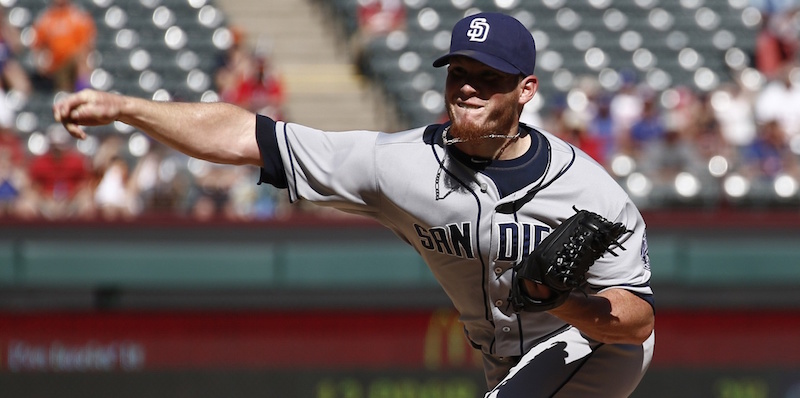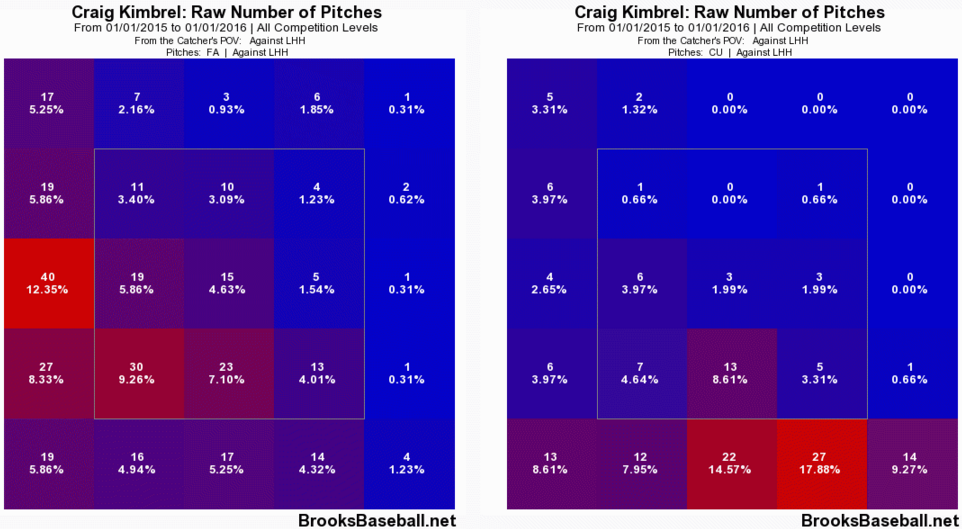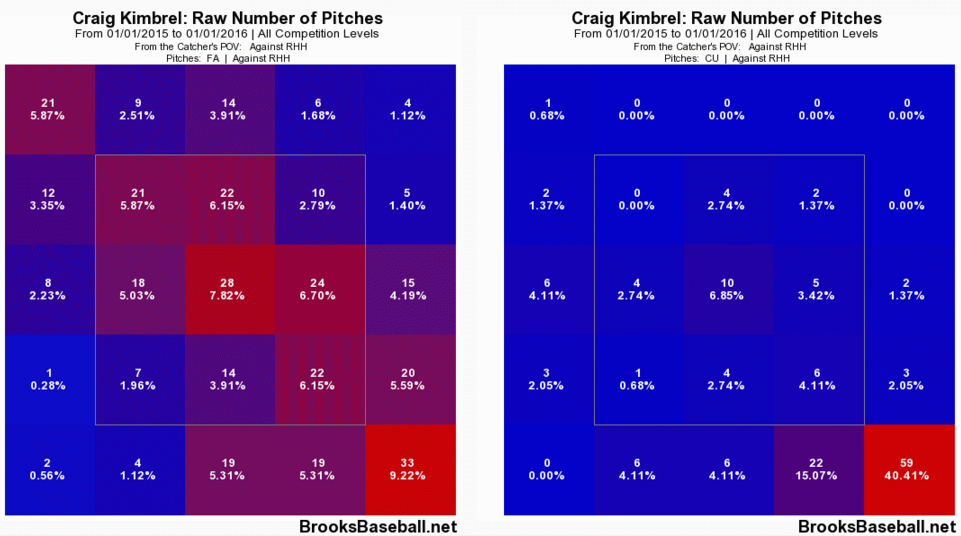Craig Kimbrel owns two of the best pitches in the game, and if you’re a relief pitcher, you don’t need much more than that. With 6,039 pitches now thrown by Kimbrel in his career, opponents have hit a paltry .182 off of his fastball, slugging .276; hitters have been even more helpless against his curveball, hitting .112 and slugging a hilarious .132. His repertoire is far less extensive, but Kimbrel’s run of success looks a lot like Pedro in his prime: power with finesse.
For all his “struggles” in 2015, we’re really only talking one or two home runs too many in April of that season: Kimbrel was exactly as dominant the rest of the year as we’ve seen him now for six seasons running. You can’t fake your way to a 1.63 career ERA in almost 350 career innings; that’s the kind of ERA mark that a great reliever gets in a single season with tons of good luck. What Kimbrel has done in the majors is mind-boggling.
Kimbrel has gotten by with a surprisingly simple approach at the plate.
How has he done it? Very unlike Pedro, Kimbrel has gotten by with a surprisingly simple approach at the plate. For the most part, it’s fastballs early and the big-breaking knuckle curve late when Kimbrel is ahead, which is often. It seems like hitters should be able to sit on one pitch or the other, and yet success against Kimbrel seems accidental when it happens. The best thing about having two nearly unhittable pitches is … that they’re nearly unhittable.
Kimbrel’s fastball isn’t all that special in terms of movement; nearly 6 inches of arm-side run and about 9 inches of “rise” is not atypical, given his velocity. In addition to hitting spots, however, it’s that velocity that has Kimbrel’s fastball standing apart. Among pitchers who threw at least 500 fourseam fastballs last year, Kimbrel had the fourth-highest average velocity. Per Brooks Baseball, at release Kimbrel maxed out over 100 mph on the fastball for all but one month last season. What’s strange is that his velocity has only gone up in his six MLB seasons.
You’ll note that Kimbrel’s curveball is also thrown with unusual velocity; he averaged a bizarre 87.8 mph out of his hand in 2015. Among pitchers who threw a curve at least 200 times in 2015, that velocity wasn’t just fast; it was over 1 mph faster than the next-highest average speed (Cody Allen), which was in turn over 1 mph faster than the third-highest. What is truly amazing is that the speed does not come with a price, in terms of movement. It doesn’t move as much horizontally, but Kimbrel’s curve breaks downward almost exactly as much, on average, as Rich Hill’s curveball — despite coming in more than 11 mph hotter.
In 2015, Kimbrel’s curve usage was up somewhat to just over 30% of pitches, his fastball coming in at just under 70% of the time. Despite his overall domination and limited repertoire, however, Kimbrel does change his two-pitch approach based on the handedness of the hitter.
Against lefties, Kimbrel follows the customary plan for getting guys out: get ahead with the fastball, then go for the jugular with a breaking ball. Lefties saw a first pitch fastball 76% of the time in 2015, and when they did, Kimbrel stayed down and stayed away. Pitching to his arm side was Kimbrel’s strategy overall facing lefties; he threw “away” over 63% of the time, on the inside third of the plate (or off of it) just over 15% of the time. Even when he was throwing his curve against lefties in 2015, Kimbrel didn’t aim for their shoetops; the curve was a little less off the plate to his glove side than it was to righties.
Kimbrel was more likely to pitch backward with a righthanded hitter at the plate, starting at bats with a curve almost one third of the time. Righties rarely swung at a first-pitch curve — just 22.2% of the time — but half of them were strikes. The tradeoff in count flexibility for the curve seems to be location, with curveballs a lot more concentrated low and away, and almost always off of the plate. When it works, it works; righthanded hitters had a whiff rate of 21.6% last year, which is high, but still unusual — especially when viewed through the lens of a lowish 37.0% swing rate. On swings themselves, RHH whiffed a hilarious 58.2% of the time.
According to the pitch classification data at Brooks, it would be a true statement to say that Kimbrel threw twice as many changeups in 2015 as he did in all previous seasons combined. Whether to consider a change part of his arsenal now is I suppose an open question, but Kimbrel’s fastball heatmap against RHH is one reason to think a change is really not that necessary right now. Doesn’t it look like Kimbrel’s bread and butter fastball is one right down the middle? It’s the kind of thing that might happen if a pitch was just so hard to hit that finesse may not be needed.
Finesse is something Kimbrel seems to have anyway; he walked 14 batters on full counts in 2015, but just 2 of those walks came with runners on base. Kimbrel appears to be reversing time with his velocity, but even if that began to slip, we’ve seen how great he can be with slightly lower readings, and that finesse is something Kimbrel seems sure to be able to tap into as needed. The Red Sox did give up quite a bit to get Kimbrel, but they did get a knockout reliever — one who seems poised to toy with AL East batters on a more regular basis in 2016.
Photo by Jim Cowsert/USA Today Sports Images


